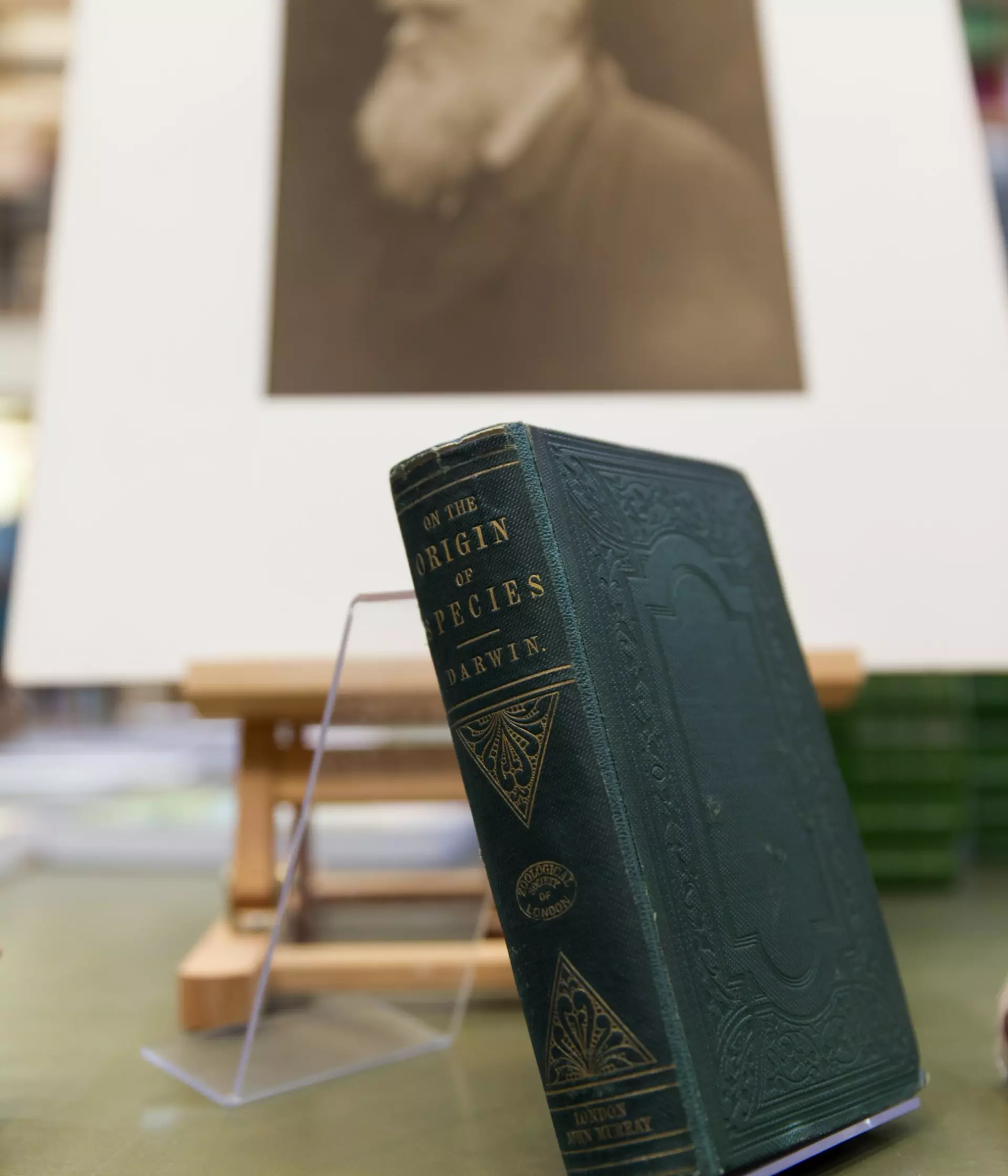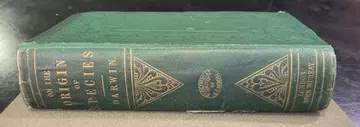
Guest blog by President of ZSL, Jim Smith
Charles Darwin and ZSL
When I came to ZSL as Secretary one of the first things I did was go to the Library and ask if we had a first edition of On the Origin of Species. We did, of course, but to my surprise we didn’t acquire it until 1899—forty years after publication! I thought there must be a story here, and the scientist and budding historian in me couldn’t resist the opportunity. It took me a year to write the piece here—partly because I spent far too long trying to find Bedfordshire auction houses, but mainly because I enjoyed it so much.
I am enormously grateful to our Library staff for their help and support: Natasha Wakely, Ann Sylph and especially Emma Milnes, with whom I enjoyed a remarkable trip to The British Library.
On the origin of ZSL's origin
There have been few books as important, influential, or controversial as Charles Darwin’s The Origin of Species (or, to give it its full title, On the Origin of Species by Means of Natural Selection, or the Preservation of Favoured Races in the Struggle for Life). Published on 24 November 1859, the book introduced the concept of evolution by natural selection, it changed the way many people thought about their place in the world, and it challenged religious orthodoxy. Some contemporaries, including Thomas Henry Huxley, accepted Darwin’s ideas immediately. ‘How extremely stupid not to have thought of that’, he wrote. Others, including Bishop ‘Soapy Sam’ Wilberforce [i], did not, and the enmity between the two inspired one of the most famous exchanges in biology, when Wilberforce asked Huxley whether it was through his grandfather or his grandmother that he claimed descent from a monkey. Huxley replied that he would not be ashamed to have a monkey for his ancestor but would be ashamed to be connected with a man who used his great gifts to obscure the truth. I wish I’d said that. [ii]

When I came to the Zoological Society of London as Secretary at the end of 2021, one of the first things I did was go to the Library to ask if I might see a first edition of the book that changed the world—we were bound, I thought, to have one. We did (Figure 1), but to my surprise, we didn’t acquire it until 1899—forty years after it was first published.
I was intrigued: did we not get a copy when it was first published? Did we buy one and lose it? And where did the current copy come from? The sixth, and final, edition of Darwin’s book had been published in 1872. Twenty-seven years after this, it can’t have been easy to find a first edition; the print run of just 1,250 copies was sold out on the first day, so by 1899 it would already have been a valuable piece. I was keen to solve these riddles, and I first asked how close the links were between Darwin and the Zoological Society of London.
Charles Darwin graduated from Christ’s College, Cambridge at the end of April 1831 (Figure 2). A few months later, on his return from a geological tour of north Wales with Professor Adam Sedgwick, he received a letter from his friend and mentor John Henslow suggesting that he join the Royal Navy surveying ship HMS Beagle as its naturalist.

Darwin was excited and delighted. He discussed the expedition with Henslow and soon set off for London and 33 Bruton Street, the then offices of the ZSL, to seek advice. He already knew the principles of taxidermy from his time in Edinburgh as a medical student, but in Bruton Street he learnt from William Yarrell, a founder member of ZSL, how to preserve his specimens and how to pack skins with tobacco, camphor, and turpentine. Darwin had been advised by FitzRoy, Captain of HMS Beagle, to buy a brace of pistols, and Yarrell was also kind enough to do the haggling for him (‘hang me if I give 60£ for pistols’, Darwin said).
Darwin had become a corresponding member of ZSL by the time of his departure on 27 December 1831, but even as he left London for Plymouth, from where HMS Beagle was to sail, he was in doubt about where to deposit his impending collection.
For the animal specimens, at least, the Zoological Society of London was the obvious place, but the museum at Bruton Street was small and over-crowded, and he wondered whether the British Museum might be a better bet.
This was a problem that was to occupy him even until the return of HMS Beagle on 2 October 1836, and although the ZSL museum had by then moved to much-improved premises in Leicester Square, he was still concerned by the lack of interest shown by the zoologists and by their behaviour towards each other. ‘I am out of patience with the Zoologists,’ Darwin said, ‘not because they are overworked, but for their mean quarrelsome spirit.’ However, the specimens had to go somewhere (he was now busy writing The Voyage of the Beagle and had no time to care for them himself), and he was worried that were they to go to the British Museum they would languish unstudied, as did so many other specimens in that museum. So it was that in January 1837, specimens comprising 80 mammals and 450 birds were taken to Leicester Square with strict instructions that they be properly mounted and catalogued.
Darwin could have done worse than deposit his specimens in the ZSL Museum. Mr Waterhouse, the curator, arranged that different species would be examined by different experts, and in particular, that the birds would be passed on to John Gould, Superintendent of the Ornithological Department. Darwin had met Gould when he visited ZSL in 1831, before setting sail in HMS Beagle, and knew him to be a talented and highly respected ornithologist. The two of them didn’t get together to discuss the specimens until March (Darwin had been in Cambridge suffering from influenza for some weeks), and the importance of this and subsequent encounters can hardly be exaggerated.
Darwin's finches
Darwin had been confused by his collection of birds. Carelessly-labelled, it seemed at first sight to contain a variety of finches, wrens, ‘Gross-beaks’ and ‘Icteruses’ (relatives of the blackbird). However, Gould quickly realised that the birds were in fact closely related, forming a group of fourteen species unique to the Galápagos Islands, differing from each other with respect to the shapes and sizes of their bills (Figure 3), and all closely related to a mainland species. Gould suspected that that these different species lived on different islands within the Galápagos, but he couldn’t be sure because the specimens were so poorly labelled. This was, no doubt, a great embarrassment to Darwin; in an effort to confirm Gould’s suspicion, he managed to get access to Captain FitzRoy’s independent HMS Beagle collection in the British Museum and, in what Janet Browne refers to as ‘a triumph of optimism over reliable information’, he was able to assign all but two species of finch to their individual islands.
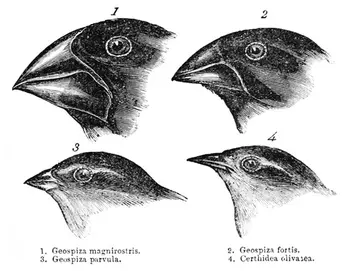
This observation was the first hint that led Darwin to realise that when populations of similar species are isolated from each other they will evolve independently such that they come best to fit their environments. In the case of the finches, the beaks changed as birds developed different tastes for seeds, fruit or insects—long pointed beaks were better for picking seeds out of cactus fruits; shorter stronger beaks did well for eating harder seeds found on the ground.
But this was not the only clue provided by Gould. A second concerned the mockingbirds that Darwin had labelled more carefully; here too, Gould showed that each of the three species was confined to its own island. And finally, on 14 March 1837, Darwin went to the ZSL to hear Gould speak about the South American 'ostriches' from Darwin’s collection. At that meeting, Gould explained that what had previously been regarded as a variant of Rhea americana was in fact a different species, which Gould proposed naming Rhea darwinii. Darwin, speaking after Gould, was able to report, perhaps in some excitement, that the new species was indeed geographically isolated from the other, confined as it was to southern Patagonia on the plains near the sea. (The name Rhea darwinii never stuck, because the French naturalist Alcide d’Orbigny had already described and named the species Pterocnemia pennata on the basis of a specimen found to the south of Buenos Aires, Argentina.)
As John van Wyhe has emphasised, the study of the evolution of ideas is as complicated as the study of the evolution of species, for one never knows what someone is thinking. Nevertheless, Darwin wrote after a meeting with John Gould that ‘One species does change into another’, and his discussions with Gould may well have provided the foundation of On the Origin of Species, and for what the philosopher Daniel Dennett described as ‘the single best idea anyone has ever had’. It seems that Darwin had many reasons to be grateful to the ZSL, and he cemented the relationship by becoming a Fellow in 1839 and serving on Council from that year until 1841.
Jenny the orangutan
Darwin made good use of his affiliation with the Zoological Society of London. Even before he became a Fellow he spoke to Yarrell about dog- and pigeon-breeding, and about how different species might be generated; he spoke again to Gould about inherited characteristics in birds; and he read widely in the zoological literature. Significantly, when the weather was fine, he would go to the Zoo in Regent’s Park, and alongside the giraffes, the rhinoceros and the elephant he met Jenny the orangutan.
The story of Jenny the orangutan has been told in a previous ZSL blog, but it is worth noting what an impression she had on Darwin. He wrote in a letter:
“the keeper showed her an apple, but would not give it her, whereupon she threw herself on her back, kicked & cried, precisely like a naughty child. - She then looked very sulky & after two or three fits of pashion [sic], the keeper said, 'Jenny if you will stop bawling & be a good girl, I will give you the apple.' - She certainly understood every word of his, &, though like a child, she had great work to stop whining, she at last succeeded, & then got the apple, with which she jumped into an arm chair & began eating it, with the most contented countenance imaginable.”
And then in his notebook:
“Let man visit Ouranoutang in domestication, hear expressive whine, see its intelligence when spoken [to]; as if it understands every word said - see its affection. - to those it knew. - see its passion & rage, sulkiness, & very actions of despair; ... and then let him boast of his proud preeminence ... Man in his arrogance thinks himself a great work, worthy the interposition of a deity. More humble and I believe true to consider him created from animals.”
Darwin was also able to explore matters such as language and tool use, and, with the arrival of Jenny’s new companion Tommy, sexual attraction and power relationships. He was delighted to find that he could carry out experiments in the city as well as in the country, and made many visits to the Zoological Society’s Gardens.
It is clear that ZSL played a significant part in Darwin’s early career and in the development of his theory of natural selection. It would have been natural for him to give ZSL’s Library, of which he had made such extensive use, a presentation copy of On the Origin of Species. But there is no record of him having done so. The Council minutes of the time recorded books received by the Society, but there was no mention of a gift from Darwin. Nor does Darwin’s correspondence mention giving a copy to the Society, and the list of recipients of On the Origin of Species in Appendix 3 of volume 8 of Darwin’s correspondence does not include the Zoological Society of London.
On 28 March 1838, Charles Darwin came to the Zoo to see Jenny. It was his first sight of an ape. Jenny made a profound impression on Darwin and influenced his work.
If Darwin did not give a copy of his book to the ZSL this might be viewed as something of a slight: he did give copies to the Royal Society, the Geological Society and the Linnean Society, and, perhaps adding insult to injury, he noted his Fellowship of these Societies, but not of ZSL, on the title page of his book (Figure 5). He also gave a copy to the Société Géologique de France.

However, I have found no record of a falling-out between Darwin and the Zoological Society of London, and Darwin did present a copy to John Gould, adding to the engraved silver compass he had given Gould as a leaving present on his departure from the Zoological Society to go to Australia in April 1838. A copy was also sent to Abraham Dee Bartlett, then Superintendent of London Zoo, who was to become infamous for selling the African elephant Jumbo to P.T. Barnum for £2,000. However, the gift to Bartlett was not until August 1860, and it is likely to have been a second edition: the first edition had sold out soon after publication, and printing of the second edition had begun within a month, on 22 December 1859; it was published in 1860. The most likely explanation for Darwin’s failure to present a copy of his book to the ZSL is therefore forgetfulness, although it is worth noting that his great critic Richard Owen was at the time Vice-President of ZSL; might this have stayed his hand?
There is no evidence that the Zoological Society of London received a presentation copy of On the Origin of Species from Darwin; did they buy a first edition at the time of original publication? Perhaps not. I have found no mention of such a purchase in the Society’s papers, and in particular the ZSL Annual Reports section on 'Some of the most important additions to the Society's Library purchased' makes no mention of On the Origin of Species. Similarly, the ‘Census of the Extant Copies of the 1st Edition of Darwin’s On the Origin of Species’, managed by Daniel Lewis, provides no clue. Rather, the earliest copy listed in the library’s current catalogue is a fifth edition, first published in 1869, acquired in 1879 (Figure 6), and at some point since then rebound by ZSL.
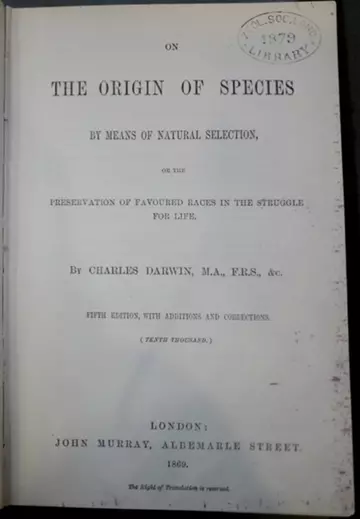
The library also holds four copies of the sixth and final edition, originally published in 1872 and represented by reprints issued in 1875, 1899, 1901 and 1902.
It is not clear why the Zoological Society of London, of all organisations, apparently did not obtain a first edition of On the Origin of Species. Although Richard Owen might have cavilled, it is unlikely that ZSL’s most senior leadership discouraged the purchase: the then-President, Albert, Prince Consort, was a strong supporter of science.
If we cannot explain ZSL’s failure to acquire a first edition of On the Origin of Species in 1859, we can say a little more about where the current copy came from. The front free endpaper has the handwritten inscription ‘St Johns Coll. Book Club. Nov. 59’ (Figure 7).
It seemed likely that this referred to St John’s College Cambridge, the sister college to Darwin’s own college, Christ’s (both were founded by Lady Margaret Beaufort, mother of Henry VII), and my enquiry to St John’s confirmed that the College’s Book Club voted in November 1859 to purchase a copy of On the Origin of Species.

The Book Club was distinct from the College Library, which did not buy a copy of the book. Perhaps the library did not realise its historical significance; perhaps the idea that modern species are the descendants of older ones, adapted by natural selection to fit their environment, was too radical for a College founded on the suggestion of His Eminence Saint John Fisher. If so, the Book Club had no such scruples, and indeed were keen consumers of Darwin’s work; they also voted on 5 December 1870 to buy The Descent of Man, to be published on 24 February 1871. (St John’s Library did eventually acquire a first edition of On the Origin of Species from the Samuel Butler Collection.)
If the St John’s College Library made a deliberate decision not to acquire a copy of On the Origin of Species, they were not alone. Professor Simon Keynes tells me that William Whewell, then Master of neighbouring Trinity College, rejected the recommendation of John Willis Clark that his library should buy a copy. But that is another story to be told by Simon.
The St John’s College Book Club held two sales a year, internal to the club, and the first edition was sold in 1861 to a Fellow of the College, John Spicer Wood, who (as far as I can tell) did not write his own name on the endpaper. Wood had taken a Bachelor of Divinity degree in 1857 and was to become Doctor of Divinity in 1869, but he must have had no religious misgivings about Darwin’s work. Wood was a loyal member of St John’s, serving as Tutor (1860-1870) and President (1871-1883), as well as Librarian (c. 1861-1882).
In 1883 he was presented by St John’s to the Rectory of Marston Morteyne in Bedfordshire (the College held the advowson from 1795 to the 20th century), and, having rebuilt the rectory the following year, he died in 1893. But what of his first edition of On the Origin of Species? Alas, the trail goes cold. Wood’s obituary, published in The Eagle, St John’s ‘annual record’ says: ‘His library was choice and clothed in handsome bindings. Unhappily the chief part of it was sold in Bedford by auction a few years ago: otherwise, if catalogued by Sotheby, it would have preserved to posterity the best notion of the man.’ It is a shame that the library was not catalogued by Sotheby: I have made enquiries of Bedford auction houses, but to no avail; I cannot yet make the link between John Spicer Wood and the Zoological Society of London.
I said, as far as I could tell, that Wood did not write his name on the endpaper. There is, however, one area of the book that is concealed to the reader, beneath the label that was firmly stuck to the book by ZSL on or around 20 March 1899 (Figure 8). Might there be a clue here?
To find out I contacted the Digitisation Services section of the British Library, to ask if we might subject this part of the book to multi-spectral imaging, perhaps to see beneath the label. Thus it was that on 28 March 2023, Emma Milnes and I took a taxi from ZSL to the BL, with our first edition carefully wrapped and carried in Emma’s deliberately and deceptively unassuming bag. We, and our insurers, didn’t want to take any chances.
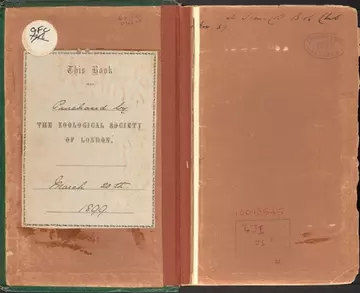
Eugenio Falcioni and Elizabeth Hunter at the BL were extraordinarily careful, skilful and kind. They studied our book with visible, infra-red and ultra-violet light, and even shone light from the side, to detect subtle indentations that might normally be invisible. Unfortunately, we could see nothing beneath the label (Figure 9); John Spicer Wood was evidently a man who respected his books and refrained from adding any notes or annotation.
This was disappointing, but not unexpected. Even if there had been any text, time and the (liberally-applied) adhesive would have made it very hard to detect some century-and-a-quarter later.

If I have failed to clear up the mystery of ZSL’s copy of On the Origin of Species, I have at least made a few steps along the way and posed some new questions. Did Darwin have a reason not to present ZSL with a first edition? And how did John Spicer Wood’s copy end up in the Library of the Zoological Society of London? Whatever the answers, I am delighted that we have a first edition of the most important book in Biology and one which, given the opportunity, I would take to my desert island in place of the Bible.
Acknowledgements
For all sorts of help, advice and encouragement I thank Emma Milnes, Ann Sylph and Natasha Wakely (ZSL Library, London), John Wagstaff (Christ’s College, Cambridge), Janet Chow, Lynsey Darby and Kathryn McKee (St John’s College, Cambridge), Janet Browne (Harvard University), Adrian Desmond, Eugenio Falcioni and Elizabeth Hunter (British Library, London), Ray Heaton, Nick Hopwood (University of Cambridge), Simon Keynes (Trinity College, Cambridge), Dan Lewis (The Huntington Library, San Marino CA), James Moore (Open University), Jim Secord (Christ’s College, Cambridge), and John van Wyhe (National University of Singapore).
Reading
Barlow, N. (Ed.) (1967). Darwin and Henslow. The Growth of an idea. Letters 1831-1860. Bentham-Moxon Trust. John Murray.
Bartlett, A.D. (1900). Bartlett’s Life Among Wild Beasts in the ‘Zoo’. Forgotten Books.
Browne, J. (1995). Charles Darwin. Voyaging. Volume 1 of a Biography. Jonathan Cape London.
Browne, J. (2003). Charles Darwin. The Power of Place. Volume 2 of a Biography. Pimlico, London.
Burkhardt, F., Browne, J., Porter, D.M. and Richmond, M. (eds) (1993). The Correspondence of Charles Darwin. Volume 8, 1860. Cambridge University Press.
Charman, Isobel (2016). The Zoo. The Wild and Wonderful Tale of the Founding of London Zoo. Penguin Books.
Desmond, A. and Moore, J. (1991). Darwin. Michael Joseph London.
van Wyhe, John (Ed.) (2002). The Complete Work of Charles Darwin Online. (http://darwin-online.org.uk/)
van Wyhe, John (2014). Charles Darwin in Cambridge. The Most Joyful Years. World Scientific Publishing.
Weintraub, S. (1997). Uncrowned King. The Life of Prince Albert. The Free Press New Yok, London, Toronto, Sydney, Singapore.
[i] It’s not clear how Samuel Wilberforce acquired his sobriquet. One suggestion is that it referred to his slipperiness in ecclesiastical arguments; another that it referred to his particular hand-washing gesture; and a third that it was inspired by Benjamin Disraeli’s comment that the Bishop's manner was 'unctuous, oleaginous, saponaceous’. Whichever of these it was, the nickname stuck.
[ii] The quote in full was:
‘If I would rather have a miserable ape for a grandfather or a man highly endowed by nature and possessed of great means and influence, and yet who employs those faculties for the mere purpose of introducing ridicule into a grave scientific discussion—I unhesitatingly affirm my preference for the ape.’
Prince Albert, then President of the Zoological Society and clearly a man possessed of a sense of humour, soon afterwards decided it would be appropriate to appoint Huxley and Wilberforce as joint Vice-Presidents of the Society.
Journey back through the most iconic moments in our two-hundred years of science, from our trailblazing first female curator to wildlife conservation break-throughs.
